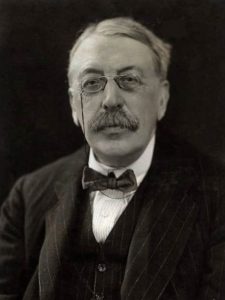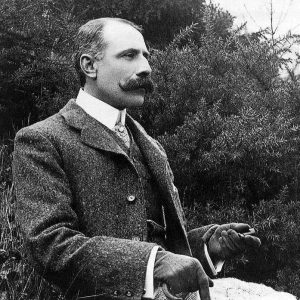Våren 2017 er det tid for et "Britisk semester".
Sammen med dirigent Timothy Miller tar vi et spennende dykk inn i deler av britisk kortradisjon. Om de to verkene vi planlegger å jobbe med i dette prosjektet skriver Miller:
"I midten av viktoriatidas England kom en eksplosjon av korsang-aktivitet. Å synge i kor ble sett på som sunt og det å lære og å lese musikk ble sett på som kraftfulle kilder til dannelse. Denne ’Choral Movement’ fikk god støtte fra regjeringen. Når mange synger må mye kormusikk skrives, og mange britiske komponister (store og små) svarte med å skrive et hav av kormusikk, både korte, lett-lærde stykker uten akkompagnement og større verk som krevde solister og orkester-akkompagnement.

Charles Villiers Stanford, PD-US, https://en.wikipedia.org/w/index.php?curid=34023460
Charles Villiers Stanford (1852-1924) skrev mye kormusikk. Songs of the Fleet (1910) bruker tekster relatert til havet og sjømannsskap. Som en nasjon opptatt av havet (to nasjonale helter var sjømenn – Sir Francis Drake og Admiral Lord Nelson) fant dette korverket en varm umiddelbar mottakelse. Publikum likte også den måten Stanford hadde skildret bølgenes rytme og havets stille uendelighet. En barytonsolist deler teksten med koret. Som vanlig på denne tiden er akkompagnementet like
effektivt i stort orkester, lite orkester eller klaver. Klaverstemmen inneholder faktisk alle essensielle detaljer.

Edward Elgar, c.a 1900.
Edward Elgar (1857-1934) har skrevet korstykker i alle formater og har gitt koristene musikk som er vital, fargerik og dramatisk. Hans Bavarian Highlands (1895) var et felles prosjekt med kona, Caroline Alice, som skrev teksten. Hva kom først, teksten eller musikken?
En kan forestille seg at begge kom mer eller mindre samtidig – noen musikalske skisser, noen ord, justering av musikken for å gi teksten en klarere tonesetting, justering av teksten for å hjelpe å ballansere musikalske fraser. Teksten og musikken ble inspirert av en ferie ekteparet nøt i Bavaria, og det hele var faktisk Fru Elgars idé. Hun tenkte at et verk inspirert av folkelige rytmer og motiver ville falle i smak blant de mange tusen Choral Societies in England, og hun hadde rett! Seinere arrangerte Elgar akkompagnementet for orkester, men opprinnelig var akkompagnementet kun for klaver. Andre sats ble så populær at Elgar tillot at den ble arrangert for mange forskjellige kombinasjoner av instrumenter. Det ble en mini ’best seller’ i sin tid."
Vi starter semesteret mandag 9. januar kl. 19.30 i Frue kirke på Storhaug, og ønsker gamle og forhåpentligvis nye medlemmer "a very warm welcome to join us".
Our project of spring 2017 will be a "British semester", as described by our conductor Timothy Miller:
"There was an explosion of interest in choral singing in mid-Victorian England. Singing was seen as a healthy activity and learning and reading music were seen as very potent educational tools. This ‘Choral movement’ received government backing. When lots of people sing, lots of music needs to be written to satisfy their demand and British composers, great and small, responded by producing an ocean of choral music ranging from short, easy, unaccompanied music to long works with requiring soloists and an orchestral accompaniment.
Charles Villiers Stanford (1852-1924) wrote a considerable amount of choral music. Songs of the Fleet (1910) are settings of poems related to the sea and seamanship. As a seafaring nation, two of whose national heroes were sailors, Sir Francis Drake and Admiral Lord Nelson, these appealed to the English. The way Stanford captured the moods and atmosphere of the sea – the rhythm of waves, the stillness of a vast ocean – was immediately attractive too. A baritone soloist shares the text with the choir. As was common at the time, the work was written in such a way to make it possible to perform effectively with a large orchestra, a small orchestra or just with the piano. The piano part is so well-written that all the essentials are represented in it.
Edward Elgar (1857-1934) has provided choirs of all sizes with music of tremendous vitality, colour and drama. His Bavarian Highlands (1895) was a joint creative effort with his wife, Caroline Alice, who wrote the words. Which came first, the words or the music? One imagines that their cooperation was so tight that both were worked on more-or-less simultaneously; musical ideas sketched out, words written to these, the music altered to set the text more convincingly, the text re-written to balance the musical phrases. The music and text were inspired by a holiday the couple enjoyed in Bavaria, but it was Mrs Elgar who suggested the idea to Edward. She saw that such a work, employing folk-music inspired motives and rhythms, would be attractive, not least to the thousands of choral societies flourishing then in England. Later Elgar arranged the accompaniment for orchestra, but the original work was written for choir and piano. The second movement became so popular that Elgar allowed it to be arranged for many different combinations of instruments. It became a minor ‘best seller’. "
We will start rehearsing on Monday the 9 of January, at 19:30. At Frue kirke on Storhaug. You are very welcome to join us.
